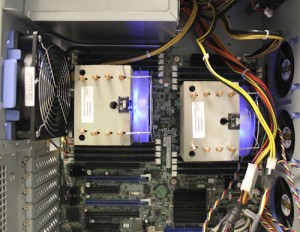TEST SETUP AND METHODOLOGY
 In testing the Samsung 845DC PRO, along with all enterprise drives, we focus on long term stability. In doing so, we stress products not only to their maximum rates, but also with workloads suited to enterprise environments.
In testing the Samsung 845DC PRO, along with all enterprise drives, we focus on long term stability. In doing so, we stress products not only to their maximum rates, but also with workloads suited to enterprise environments.
We use many off-the-shelf tests to determine performance, but we also have specialized tests to explore specific behaviors we encounter. With enterprise drives, you will see that we do not focus on many consumer level use-cases.
Our hope is that we present tangible results that provide relevant information to the buying public.
LATENCY
To specifically measure latency, we use a series of 512b, 4K, and 8K measurements. At each block size, latency is measured for 100% read, 65% read/35% write, and 100% write/0% read mixes.
This is very low latency. We normally don’t see anything in that range on SATA devices, especially for writes.
Even more impressive is the maximum latency. Almost off of our results were under 10ms, with maximum read latency under 2ms.
ADVANCED WRITE TESTING
As we talked about in our Micron P400m SSD Review, SSDs have different performance states. Since the Samsung 845DC PRO is an enterprise SSD, we will focus on steady state performance. With the following tests, we stressed the drive using random 4KB write workloads across the entire span for at least 24 hours. This is more than enough to achieve steady state. The following graph is showing the latency and IOPS across an 11 hour span.
These were the sort of results that we were hoping for. Not only did we blow by the 50K IOPS number from the datasheet, the 845DC PRO did it consistently. In our per minute average, we did not see more than a 500 IOPS swing across 11 hours.
Zooming in on the last hour shows results that do not disappoint. We are still seeing the 50K IOPS and a very tight grouping of data. Almost all of the datapoints are over 50K IOPS, with just a few falling short of that number. For a 6Gbps SATA device, this is tops for a standard configuration. We have reviewed drives from Intel, Micron and SMART that have posted IOPS in the mid-30K IOPS range, but never 50K. In order to get that level of write IOPS, you need either a PCIe or 12Gbps SAS interface. In every single one of those cases, you are paying way more than $2/GB.
 The SSD Review The Worlds Dedicated SSD Education and Review Resource |
The SSD Review The Worlds Dedicated SSD Education and Review Resource | 

There seem to be two errors in the images for the “Fileserver profile” and the “Webserver profile”. The names in those charts tell me that those results are for the 845DC EVO and not the 845DC PRO.
The “Fileserver profile” result looks like a typo (result is better then in the actual 845DC EVO test so this seems to be the 845DC PRO result).
The result of the “Webserver profile” looks pretty much exactly as the 845DC EVO result. Maybe there is indeed no difference to speak of in this test scenario.
For the wishlist: A direct comparison of the 845DC PRO and the 845DC EVO would be nice. 🙂
In general the new 845DC PRO looks nice but it’s way to expensive when you compare it against the price range of the consumer versions including let’s say a +25-50% price tag for the DataCenter SSD.
Internally there is not that much different except for the obvious (DataCenter SSD: better/optimized Firmware, lower clocked Controller, less packed/layered 3D NAND, [better/more] Capacitors).
The price for the Intel DC S3700 and SanDisk Optimus EVO [SAS instead of SATA-Interface] is the same in Germany for the 400 GB version (on the 800 GB version the Intel is more expensive).
So if I would have to decide (incl. the 845DC PRO) I would get the SanDisk (cheaper and better performance in most usecases) as long as the Samsung is more expensive.
I’m currently about to buy several DataCenter SSDs for my “HomeServer” (Database/DWH, OLAP; SAS RAID-Cache Controller with BBU; planned a RAID-6). Currently it seems I might actually try the 845DC EVO. The money I save for other SSD options will go into additional memory modules.
“All of this performance is for not…”
“Naught”, not “not”.
The 845DC Pro is just a new name for an existing drive. SV843 is exactly the same drive (just using 7% OP instead of 28% OP),… and SV843 is much cheaper! If you change values to 28% on the SV843 you’ll get the same performance as 845DC. Same like 845DC EVO = PM853T. Both products are just sold by 2 different operations (Electronis and Semiconductor) Cheers